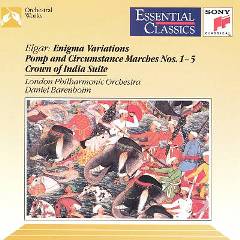Elgar - Enigma Variations/Military Marches/The Crown of India (1992)
Elgar - Enigma Variations/Military Marches/The Crown of India (1992)

Variations On An Original Theme,Op.36 'Enigma' 1. Enigma, Andante 2. Var. I (C.A.E.) L'Istesso Tempo 3. Var. II (H.D.S.-P.) Allegro 4. Var. III (R.B.T.) Allegretto 5. Var. IV (W.M.B.) Allegro Di Molto 6. Var. V (R.P.A.) Moderato 7. Var. VI (Ysobel) Andatino 8. Var. VII (Troyte) Presto 9. Var. VIII (W.N.) Allegretto 10. Var. IX (Nimrod) Adagio 11. Var. X Intermezzo (Dorabella) Allegretto 12. Var. XI (G.R.S.) Allegro Di Molto 13. Var. XII (B.G.N.) Andante 14. Var. XIII Romanza (***) Moderato 15. Var. XIV Finale (E.D.U.) Allegro-Presto Pomp And Circumstance - 5 Military Marches, Op. 39 16..1 In D Major 17. No.2 In A Minor 18. No.3 In C Minor 19. No.4 In G Major 20. No.5 In C Major The Crown Of India - Suite, Op.66 21. I. Introduction - Dance Of Nautch Girls 22. II. Menuetto 23. III. Warriors' Dance 24. IV. Intermezzo 25. V. March Of The Mogul Emperors London Philharmonic Orchestra Daniel Barenboim – conductor
At the end of an overlong day laden with teaching and other duties, Edward Elgar lit a cigar, sat at his piano and began idling over the keys. To amuse his wife, the composer began to improvise a tune and played it several times, turning each reprise into a caricature of the way one of their friends might have played it or of their personal characteristics. "I believe that you are doing something which has never been done before," exclaimed Mrs. Elgar. Thus was born one of music's great works of original conception, and Elgar's greatest large-scale "hit": the Enigma Variations. The enigma is twofold: each of the 14 variations refers to a friend of Elgar's, who is depicted by the nature of the music, or by sonic imitation of laughs, vocal inflections, or quirks, or by more abstract allusions. The other enigma is the presence of a larger "unheard" theme which is never stated but which according to the composer is very well known. The identity of the phantom tune left the world with the composer, and guesses have ranged from "God Save the King" to a simple major scale. --- Wayne Reisig, Rovi
Elgar's first five Pomp and Circumstance Marches make a wonderfully diverse set of pieces, yet the name, and the shared structure of alternating scherzo and trio sections, identify these five marches as a single work. Their publication dates from different times in the composer's career, ranging from 1901 to 1930, but these dates are somewhat deceptive. Elgar produced no completely original work after Alice's death in 1920, and the fifth march is based on ideas Elgar had jotted down many years earlier, making the five marches far more contemporary in conception (and the note on the 6th March shows this to be far earlier than its numbering suggests). Elgar was concerned to treat the quick march in a symphonic style, much as the minuet, waltz or polka had been used by earlier composers. Sir John Hawkins, in his eighteenth-century "History of Music" wrote "It seems that the Old English March was formerly in high estimation, as well abroad as with us its characteristic is dignity and gravity." Certainly no one knew better than Elgar how to retain the essential dignity of the March: his is a superb set full of masterly orchestration, and he was rightly proud of them. --- elgar.org
In 1911, King George V and Queen Mary were crowned in India. To commemorate the event, a huge masque was commissioned and staged at the Coliseum Theatre in London in March 1912. As composer of the Coronation Ode, written for King Edward VII's planned coronation in 1902 and revived in 1911 for King George's coronation, it was natural that Elgar should be approached to write the incidental music to accompany the masque. Elgar composed twelve pieces for the masque, around sixty minutes of music in total, for contralto, bass, chorus and orchestra. He subsequently extracted five of these and added an intermezzo for solo violin to form a suite, first performed at the Three Choirs Festival in Hereford in September 1912. It is in this form that the work is normally heard today. --- elgar.org
download: uploaded anonfiles yandex 4shared solidfiles mediafire mega filecloudio
Last Updated (Tuesday, 05 November 2013 16:01)








